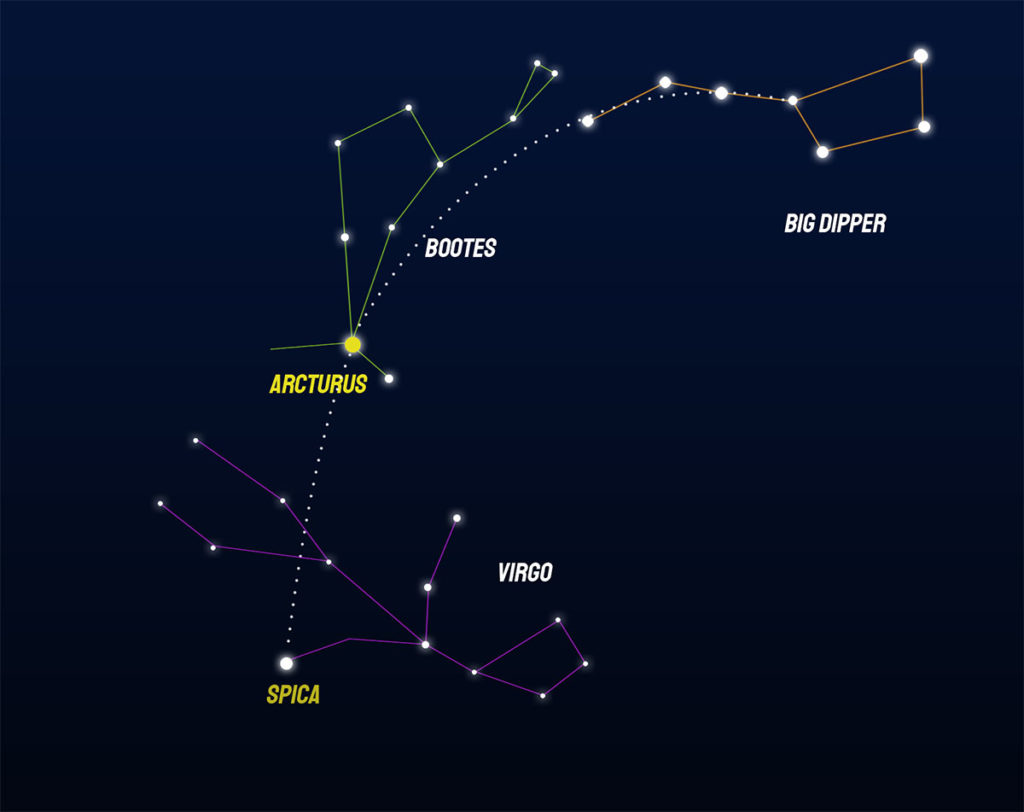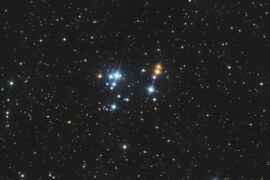Libra is one of the 12 zodiac constellations in the ecliptic, and one of the 88 constellations in the catalog of the International Astronomical Union. Learning how to find Libra in the night sky is very easy when you follow a couple steps explained below.
Libra is one of the simplest shaped constellations. It’s main body is formed by only 6 stars that according to the mythology, are shaped like an old scale and represents balance.
Here are some other quick stats about Libra:
| Common name | Libra |
| Abbreviation | Lib |
| Genitive (scientific name) | Librae |
| Main stars | 5 |
| Bayer stars | 56 |
| Discovered stars with planets | 4 |
| Quadrant | SQ3 |
| Meaning | Scales, balance |
| Meteor showers | May Librids |
| Brightest star | Zubeneschamali |
| Neighboring Constellations | Virgo, Scorpius, Ophiuchus |
When and Where is the Libra constellation visible in the sky
Libra can be seen in the sky between December and August in the U.S., Europe, and the rest of the Northern hemisphere. The best time to watch it, and when it is easiest to find, is in June when it is directly overhead around 9:00 PM.
Between September and November, Libra is positioned behind the Sun, making it impossible to observe from Earth.
Here’s a handy table that will help you find it depending on the time you observe the sky. This data is for the Northern hemisphere (U.S. and Europe)
| Before 9:00 PM | May – Eastern sky June, July – Overhead August – Western sky |
| 9:00 PM – 12:00 AM | April – Eastern sky May, June – Overhead July, August – Western sky |
| 12:00 AM – 4:00 AM | February to April – Eastern sky May – Overhead June – Western sky |
| 4:00 AM – Sunrise | December, January – Eastern sky February – Overhead March, April – Western sky |
As seen in the table above, Libra moves between the Eastern and Western sky depending on the month and the time of the night you observe it.
It is located in the SQ3 quadrant and crosses the ecliptic plane just like the rest of the zodiac constellations. The ecliptic line or ecliptic plane is the imaginary line that follows the path Earth trajectory around the Sun.
How to find the Libra constellation
The brightest star in Libra is Beta Librae, more commonly know as Zubeneschamali. This star only has an apparent magnitude (brightness) of 2.6. For comparison, Sirius, the brightest star we can see from Earth has an apparent magnitude of -30. Remember that in magnitude, less means brighter.
Because Libra doesn’t contain stars that are too bright and easily recognizable, the easiest path to find it is to locate first a more recognizable constellation and go from there. Still, it is a very easy process that you can master in a couple of minutes by following 3 simple steps.
Step 1: Locate the Big Dipper
The Big Dipper is an easy-to-find asterism (kind of like an unofficial constellation) located in the Ursa Major constellation. It is visible all year long in most places in the U.S., Canada and Europe.
All you really need to do find it is look North. You will see two constellations shaped like a dipper or ladles. The bigger one is aptly known as the Big Dipper.
If you have trouble finding North and you don’t have a phone with a compass, here’s a guide on how to find it using some handy tricks.
Step 2: Find Arcturus
Arcturus is a huge, bright star that is part of the Boötes constellation. It is easily recognizable because, on top of being very bright, it also has a yellowish hue.
In order to find it, simply draw an imaginary curve extending the handle of the Big Dipper in the direction opposite of the bucket. The following diagram explains it best.
Step 3: Follow the path to Virgo
Using that same line from Arcturus, keep going in direction to the horizon. You will run into a bright white star called Spica. This star is the “hand” of the Virgo constellation, also known as the maiden. Look at the starts around Spica to identify the Virgo constellation. It kind of looks like a stick figure on its side.
Step 4: Just look West to find Libra
Once you have identified Virgo, simply look a little bit to the West. Libra is right besides Virgo and should be easy to identify once you know where to look for it.
Identifying the shape of Libra
Once you know where to look for it, identifying the two brightest stars in Libra, Zubeneschamali and Zubelnegenubi can be quite easy. From there you can trace the rest of its shape simply by tracing imaginary lines starting from those two points. Here are some general rules:
- Gamma Librae forms a scalene triangle with Zubeneschamali, and Zubelnegenubi. The horizontal distance from it to Zubeneschamali is about half the distance from Zubeneschamali to Zubelnegenubi.
- Upsilon Librae, the star that forms the western scale, can be located because Antares, a very bright star in the neighboring Scorpius constellation, is almost exactly at the halfway point between Upsilon Librae, and Gamma Librae.
- Sigma Librae is at a bit of an angle to the inside part of the constellation. It forms almost a perfect Isosceles triangle with Zubeneschamali and Zubelnegenubi.
Stargazing tips to watch Libra
To improve your experience when trying to look for any constellation, it’s best to find the right conditions. This is especially true with constellations like Libra because its stars are relatively dim.
Clear weather plays a big part in watching stars. A cloudy and rainy night is going to make it hard to look at the stars.
Libra will be harder to find in big cities due to light pollution. The farther away you are from city lights, the better your experience will be when it comes to stargazing.
A telescope is not necessary to watch Libra, ancient Greeks and Romans observed it and they didn’t have one, but a basic telescope, even a small one will help when the two conditions above are not the best.
How to find more constellations
Aries – Taurus – Gemini – Cancer – Leo – Virgo – Libra – Scorpius – Saggitarius – Capricornus – Aquarius – Pisces
Enjoyed this article?
Get daily 10-minute PDFs about astronomy to read before bed!
Sign up for our upcoming micro-learning service where you will learn something new about space and beyond every day while winding down.












